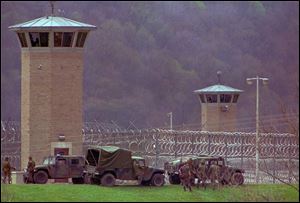
Union: State forgetting lessons learned in Lucasville prison riot
4/4/2013
Law officers and National Guard troops assemble outside the Southern Ohio Correctional Facilty April, 1993 as a riot by inmates enters its 10th day.
COLUMBUS — On Easter Sunday, April 11, 1993, inmates at the Lucasville prison in southern Ohio rioted. By the time the siege ended 11 days later, nine inmates and one correctional officer were dead.
As the 20th anniversary approaches, five inmates still await execution for their roles in those murders.
The union representing correctional officers and some other employees at prisons said today that Ohio is forgetting lessons it learned from Lucasville as budget cuts take their toll on staffing levels, even as inmate populations far exceed the buildings' designed capacities.
“It looks like a lot of the red flags in the early 1990s are flashing again in Ohio,” said Paul Goldberg, the former executive director of the Ohio Civil Service Employees Association, who wrote a report on the Department of Rehabilitation and Correction's needs in the wake of the Lucasville riot.
At the time of the riot, Ohio’s prison system was operating at roughly 50 percent above capacity. Today, it’s closer to 30 percent overcapacity as the state works to reduce population through alternative sentencing and drug treatment.
But the union argues that those reforms have not yet had much impact. The 904 new corrections positions added immediately after the riots have since been eliminated, as have 771 more, during a new era of budget cuts. Twenty years ago, the system's inmate-to-staff ratio was 8 to 1. It’s about 7 to 1 now.
“That’s not much progress,” said state Rep. Matt Lundy (D., Elyria), a former Toledo television news anchor. “That’s not progress at all. It’s setting the fuse for another Lucasville disaster.… Have we not learned from our mistakes?”
Overcrowding and gang activity were among the issues blamed for the riot at Lucasville, officially known as the Southern Ohio Correctional Facility. Although Death Row is no longer at the prison, Ohio's execution chamber is. The five inmates sentenced to death for their roles in the deaths of nine inmates and correctional officer Robert Valleningham await dates for their return to Lucasville and the lethal-injection gurney there.
Among them is James Were, also known as Namir Abdul Mateen, who the Ohio Supreme Court recognized as having supervised Mr. Valleningham's strangulation at other inmates' hands. Were was serving a sentence for a Lucas County aggravated robbery conviction at the time of the Lucasville riot.
The union blames overcrowding and correctional-officer cutbacks in recent years for an increase in violence at prisons, as well as rising crime by inmates against staff. A recent state report suggested that one in six inmates in the state prison system is a gang member.
Two Toledo Correctional Institution inmates were recently murdered, both strangled by fellow inmates.
Lawrence Michael Hensley, 43, formerly of Sidney, Ohio, has been indicted for aggravated murder in the killing of Bradley L. Hamlin, 24, formerly of Mantua, Ohio, who was strangled Sept. 20 and died two days later in a hospital. Hensley was incarcerated at the time on murder and other convictions out of Shelby County.
No arrest has been made yet in the March death of Auturo Lopez, 43, formerly of Port Clinton, at the Toledo prison.
DRC spokesman JoEllen Smith said recent reforms to crack down on prison violence are beginning to have an effect.
“Calendar 2012 was the first full year of our violence reduction reforms being in place, and the data reflects that because of these initiatives, we are beginning to see positive results,” she said. “We have seen a 7.2 percent reduction in total violent rule infractions, and the number of disturbances also decreased.”
Assaults and harassment rule infractions, however, are up and remain an area of focus, she said.